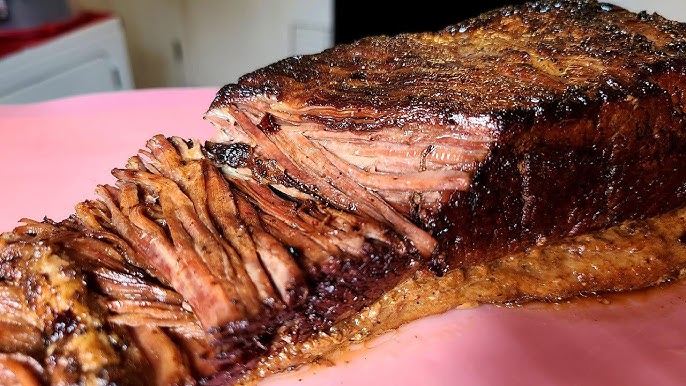Oven Brisket Recipe: There’s something magical about a perfectly cooked brisket. It’s juicy, tender, and packed with flavor.
And contrary to popular belief, you don’t need a smoker or fancy grill to pull it off. All you need is your trusty oven, a little patience, and the right recipe.
This step-by-step guide will walk you through everything you need to know to make the ultimate oven-baked brisket that’ll wow your family, guests, or even just yourself. Let’s dive in.
Why Oven-Baked Brisket is a Game-Changer
If you’ve ever felt intimidated by brisket, you’re not alone. Traditionally smoked for hours, this cut of meat can feel like a serious commitment. But when you bake it in the oven, the process becomes way more approachable and still delivers mouthwatering results.
The oven provides a controlled environment. No worrying about keeping a smoker at a consistent temperature. No need for wood chips or charcoal. You just season, bake, and relax. What’s not to love? Plus, your house fills up with an incredible aroma that builds anticipation with every passing hour.
What makes oven-baked brisket such a winner is its simplicity. You don’t sacrifice flavor, and with the right preparation, the meat comes out fork-tender with a beautiful bark. It’s perfect for busy families or when you just want low-effort, high-reward cooking. Think of it as the comfort food hero you didn’t know you needed.
The Secret to Tender and Flavorful Brisket
The real magic of brisket is in the “low and slow” cooking method. This isn’t a quick dinner; it’s a labor of love. But it pays off big time.
Brisket is a tough cut, taken from the lower chest of the cow. It’s full of connective tissue, and unless you cook it long enough, it can be chewy and dry. That’s where time and temperature come into play. Low oven heat—usually between 275°F to 300°F—gives the connective tissues time to break down into gelatin, making the meat incredibly tender and juicy.
Then there’s the flavor factor. Seasonings, marinades, and spice rubs get a chance to sink into the meat during the slow roast, enhancing every bite. Combine that with a proper sear or crust, and you’ve got yourself a showstopper.
Choosing the Right Cut of Brisket
Point Cut vs. Flat Cut – Which One to Pick?
When it comes to brisket, you’ll usually find two cuts: the point cut and the flat cut. Understanding the difference can really impact your results.
- Flat Cut (First Cut): This is the leaner part of the brisket. It’s rectangular, easy to slice, and generally more uniform in thickness. It’s great for presentation and perfect if you’re feeding a crowd.
- Point Cut (Second Cut): This cut is thicker, with more marbling and fat. That means it’s juicier and has a deeper flavor. But it’s also more irregular in shape, so slicing it evenly can be trickier.
If it’s your first time cooking brisket in the oven, go with the flat cut. It’s easier to manage, especially when learning the timing and temperature. But if flavor is your top priority and you don’t mind a bit of a rustic look, the point cut delivers bold, beefy deliciousness.
Ideal Size and Weight for Oven Cooking
For home ovens, the sweet spot is a brisket between 4 to 6 pounds. This size fits comfortably in most roasting pans and cooks evenly without taking up your entire day.
Here’s a quick guide to how size affects cooking time:
- 4 lbs brisket – About 4.5 to 5.5 hours
- 5 lbs brisket – About 5.5 to 6.5 hours
- 6 lbs brisket – Around 6.5 to 7.5 hours
Don’t forget—these are just estimates. Always use a meat thermometer to confirm doneness (you’re aiming for an internal temp of around 195°F to 205°F for ultimate tenderness).
Ingredients You’ll Need
Brisket Marinade Essentials
The marinade is where you infuse flavor deep into the meat. You can go bold and smoky, sweet and spicy, or keep it herbaceous and savory. Here’s a solid go-to marinade to start with:
Ingredients:
- 1/4 cup soy sauce
- 1/4 cup Worcestershire sauce
- 2 tablespoons apple cider vinegar
- 2 tablespoons olive oil
- 1 tablespoon Dijon mustard
- 1 tablespoon brown sugar or honey
- 3 cloves garlic, minced
- 1 teaspoon smoked paprika
- 1 teaspoon onion powder
- 1 teaspoon black pepper
Mix all these in a bowl and pour over your brisket, preferably in a zip-top bag or sealed container. Let it marinate in the fridge for at least 8 hours—overnight is ideal.
This combo balances saltiness, tang, and a touch of sweetness, making it a flavor bomb once cooked.
Spice Rub Ingredients
If you’re not marinating (or even if you are), a spice rub builds that incredible crust or “bark” that makes brisket so irresistible.
Basic Dry Rub Mix:
- 2 tablespoons kosher salt
- 1 tablespoon ground black pepper
- 1 tablespoon smoked paprika
- 1 tablespoon garlic powder
- 1 tablespoon onion powder
- 1 teaspoon cayenne (optional for heat)
- 1 teaspoon brown sugar (for a touch of caramelization)
Rub this all over the brisket, pressing it into the meat so it adheres well. Let it sit for at least 30 minutes before baking—or overnight for maximum flavor.
Preparing the Brisket
Trimming Excess Fat
Fat adds flavor, but too much of it can leave your brisket greasy instead of juicy. You want to keep about 1/4 inch of fat on the top. This “fat cap” helps protect the meat during the long cook and bastes it as it melts.
Use a sharp knife to trim any thick, hard fat that won’t render down. Be careful not to cut into the meat itself. Think of it as shaping the brisket for even cooking and better texture.
Marinating for Maximum Flavor
Once your brisket is trimmed and seasoned, it’s time to let the flavors soak in. If you’ve got the time, marinating it overnight is the best way to go. Place it in a ziplock bag or a deep pan, pour in the marinade, and cover it tightly.
Let it sit in the fridge for 8 to 12 hours, flipping it once halfway through so both sides soak evenly. Pull it out and let it come to room temperature before placing it in the oven. This helps it cook more evenly and prevents the outer edges from overcooking before the center is done.
Step-by-Step Cooking Instructions
Preheating and Pan Preparation
Alright, so your brisket is seasoned, marinated, and ready to roll—now it’s time to set the stage. Preheat your oven to 300°F (150°C). This low temperature is perfect for breaking down those tough fibers and rendering all the fat slowly and evenly.
Next up: pan prep. Use a large roasting pan or a deep baking dish that can comfortably hold the brisket without cramming it in. You want a bit of space around the meat for air circulation. If possible, choose a pan with a lid—or have some heavy-duty aluminum foil on hand to seal it tight.
Add a bit of moisture to the pan. This step is crucial to keep the meat from drying out. You can pour in:
- 1 cup beef broth or stock
- 1/2 cup of the leftover marinade (if not too salty)
- A splash of red wine or beer for extra depth (optional)
This liquid helps steam and baste the meat throughout the cooking process.
Place a rack inside the pan if you have one, then lay the brisket fat-side up. This way, as the fat melts, it self-bastes the meat.
Slow Roasting Techniques
Once the brisket is in the pan and the oven is preheated, cover the pan tightly with a lid or foil. Make sure it’s sealed well—you don’t want that moisture escaping.
Place the pan in the middle rack of the oven and roast at 300°F. Use the general rule of thumb: 1 hour per pound of brisket. So a 5-pound brisket will need about 5 hours to become beautifully tender.
Resist the urge to check on it constantly. Opening the oven lets heat escape, messing with the slow-cooking magic. At most, check it once halfway through to make sure there’s still enough liquid. Add a bit more broth if the bottom of the pan is dry.
Optional step: For an extra crusty bark, uncover the brisket during the last 45 minutes of cooking and increase the oven temp to 350°F. This helps form that irresistible caramelized exterior.
Checking for Doneness
Now, here’s where it gets real. Time alone doesn’t determine when your brisket is done—temperature and texture do.
Insert a meat thermometer into the thickest part of the brisket. You’re looking for an internal temp of 195°F to 205°F. This is the sweet spot where the collagen has broken down enough to give you that melt-in-your-mouth feel.
But there’s another test that’s just as important—the poke test. Use a fork or skewer to gently press into the meat. It should slide in with almost no resistance, like soft butter. If it’s still tough or springy, it needs more time.
Once it hits that magic zone, take it out of the oven and get ready for the next crucial step.
Letting It Rest and Carving
Importance of Resting the Meat
You’ve waited hours for this moment, but don’t dig in just yet. Resting the brisket is absolutely non-negotiable. When you cook meat, all the juices get excited and rush to the center. Slicing it right away will cause them to spill out onto your cutting board instead of staying inside the meat.
Loosely tent the brisket with foil and let it rest for at least 30 minutes—up to an hour if you have the time. During this period, the juices redistribute evenly, and the meat finishes cooking gently from residual heat.
Want an extra pro tip? Wrap the rested brisket in butcher paper or foil, place it in a cooler (without ice), and close the lid. This keeps it hot for hours and gives you flexibility in serving time, especially if guests are running late.
Slicing Tips for the Perfect Cut
The moment of truth: slicing. This can make or break the presentation and texture.
Start by identifying the grain of the meat—the direction the muscle fibers run. You want to cut against the grain, not with it. This shortens the fibers in each bite, making the meat more tender and easier to chew.
Use a long, sharp slicing knife, not a serrated one. Cut in smooth, even strokes rather than sawing. For flat cuts, go with slices about 1/4 inch thick. For the point cut, you can go a bit thicker since it’s fattier.
Arrange the slices neatly on a platter, spoon a little of the pan juices over the top, and get ready for applause from whoever’s lucky enough to be around your dinner table.
Serving Suggestions
Best Side Dishes for Brisket
Brisket is rich, meaty, and full of bold flavors—so it pairs well with sides that balance and complement that depth. Here are some classic and creative options:
- Mashed Potatoes – Creamy, buttery potatoes are a timeless partner.
- Coleslaw – Adds a crunchy, tangy contrast that cuts through the richness.
- Roasted Vegetables – Carrots, parsnips, and brussels sprouts caramelized to perfection.
- Cornbread or Dinner Rolls – Perfect for soaking up all those amazing juices.
- Mac and Cheese – Because you’re already going big, might as well go all the way.
For a lighter option, serve brisket over a bed of fresh arugula or spinach with a lemony vinaigrette.
Sauces and Garnishes
A great brisket can stand on its own—but a killer sauce takes it over the top.
Top sauces to try:
- Homemade BBQ Sauce – Sweet, tangy, and smoky
- Chimichurri – Bright, herby, and garlicky
- Horseradish Cream – Spicy and creamy for a punchy contrast
Garnish with freshly chopped parsley or green onions for a pop of color and freshness. And don’t forget a lemon wedge or two for guests who like a citrusy zing.
Storing and Reheating Leftovers
Best Storage Practices
Brisket is one of those rare dishes that tastes just as good the next day—sometimes even better. The key is storing it right.
Once the brisket has fully cooled, slice it up and place it in an airtight container. Add a few spoonfuls of the pan juices or broth to keep it moist. Seal it tight and store it in the fridge for up to 4 days.
For longer storage, freeze slices individually wrapped in foil, then place them all in a freezer-safe bag. This way, you can thaw and reheat only what you need.
Reheating Without Drying Out
To reheat brisket without turning it into beef jerky, you’ve got a few solid options:
- Oven Method: Place slices in a baking dish, add a bit of broth or pan juices, cover with foil, and heat at 300°F for 20–30 minutes.
- Stovetop Method: Heat slices in a skillet with a splash of broth, covered, on low heat until warmed through.
- Microwave: Use a microwave-safe dish, cover with a damp paper towel, and heat in short bursts—30 seconds at a time.
Whichever method you choose, low and slow is still the name of the game. Keep it gentle to preserve that juicy texture.
Common Mistakes to Avoid
Overcooking or Undercooking
Brisket is a cut that demands precision and patience. One of the biggest mistakes you can make is either overcooking or undercooking it. Too little time in the oven, and your brisket will be chewy and tough; too much, and it becomes dry, stringy, and unappealing.
Here’s the trick: it’s not just about time—it’s about internal temperature and texture. Aim for that golden zone between 195°F and 205°F. That’s when all the connective tissues have melted into gelatin, giving you that buttery softness we all crave in a perfect brisket.
A meat thermometer is your best friend here. Don’t guess or go by color alone. And if you’re ever unsure, err on the side of slightly longer cooking, but always keep the brisket covered and moist to prevent it from drying out.
Not Seasoning Enough
Brisket is a thick, hearty cut of beef—it can handle a bold seasoning profile. A common rookie mistake? Being too shy with your rub or marinade. If you under-season, the meat’s flavor won’t pop, no matter how well it’s cooked.
Make sure to cover every inch of the brisket in your rub, pressing it firmly into the surface. This isn’t just for flavor—it also helps develop that beautiful crust. And don’t forget the sides and edges. You want every bite to be a flavor bomb.
Also, if you’re marinating, let it sit long enough to absorb the flavors, ideally overnight. A quick 1–2 hour soak won’t cut it. Give the seasoning time to work its magic.
Final Tips for a Foolproof Brisket
Cooking brisket might seem intimidating, but once you get the basics down, it’s really just a slow roast that rewards you for being patient. Here are some final tips that can elevate your brisket game from good to unforgettable:
- Use a roasting rack to keep the meat elevated above the liquid. This helps prevent soggy bottoms and ensures more even cooking.
- Rest your brisket properly. No exceptions. That 30-minute rest allows the juices to settle and makes a huge difference in tenderness.
- Don’t rush it. Even if your brisket hits 195°F early, give it time to go just a little further. Tenderness is about feel as much as temp.
- Save those drippings. Skim the fat and turn them into a savory gravy or sauce. Liquid gold.
- Slice against the grain. Always. This makes even lean cuts feel tender and melt-in-your-mouth delicious.
And above all—trust the process. Brisket isn’t about instant gratification. It’s about building anticipation and delivering pure, beefy satisfaction at the finish line.
FAQs about Oven Brisket Recipe
1. What temperature should I cook a brisket in the oven?
For optimal tenderness and flavor, cook your brisket in the oven at a low temperature, typically around 300°F (150°C). This slow cooking process allows the fat to render and the connective tissues to break down, resulting in a succulent and juicy brisket.
2. How long does it take to cook a brisket in the oven?
The cooking time for brisket in the oven depends on the size of the meat cut. Generally, you should allocate about 1 hour per pound at 300°F. For example, a 5-pound brisket would typically take about 5 hours to cook.
3. Should I wrap my brisket in foil while cooking?
Wrapping brisket in foil can help retain moisture and speed up the cooking process. This technique, known as the ‘Texas Crutch,’ is particularly useful to prevent the brisket from drying out and to achieve a more tender result. Consider wrapping your brisket after the first 2-3 hours of cooking.
4. What is the best way to keep brisket moist?
Keeping your brisket moist involves a few techniques:
- Basting: Periodically spooning the juices over the brisket during cooking.
- Marinades and Rubs: Applying a marinade or rub before cooking can help retain moisture and flavor.
- Cooking Liquid: Adding a bit of broth or water in the cooking tray can create a humid environment in the oven, which helps keep the meat moist.
5. Can I cook brisket in the oven overnight?
Yes, cooking a brisket in the oven overnight is an excellent way to ensure it’s incredibly tender. Set your oven to a lower temperature, around 225°F to 250°F, and let it cook slowly overnight. Make sure to check the internal temperature to avoid overcooking.
6. What internal temperature should brisket reach?
Brisket is best cooked to an internal temperature of about 195°F to 205°F. This range ensures that the connective tissues have properly broken down to create a tender, flavorful meat.
7. How do I know when my brisket is done?
Besides reaching the correct internal temperature, a well-cooked brisket should be tender enough to pull apart with forks. The meat should feel soft and tender when probed with a thermometer or fork.
8. Should I let brisket rest after cooking, and for how long?
Yes, it’s essential to let your brisket rest after cooking to allow the juices to redistribute throughout the meat. A good rule of thumb is to let it rest for at least 20 minutes before slicing. For larger cuts, resting for up to an hour can be beneficial.
9. Can I prepare brisket ahead of time?
Absolutely. Brisket can be cooked ahead of time and reheated. In fact, brisket often tastes better the next day as the flavors have more time to meld. Store it in the refrigerator, and reheat it slowly in the oven at a low temperature to maintain its moisture.
Conclusion
There you have it—a complete, no-fail guide to making oven brisket that’s juicy, tender, and packed with mouthwatering flavor. Whether it’s for a holiday, a weekend treat, or just because you’re craving something epic, this recipe is your golden ticket to brisket greatness.
What’s awesome is that you don’t need a smoker, a grill, or any fancy equipment. Just your oven, a little prep, and some patience. From choosing the right cut to seasoning, slow roasting, resting, and slicing—every step counts. But once you master the rhythm, it becomes second nature.
Now it’s your turn. Grab a brisket, follow these steps, and make some magic in your kitchen. You got this.



